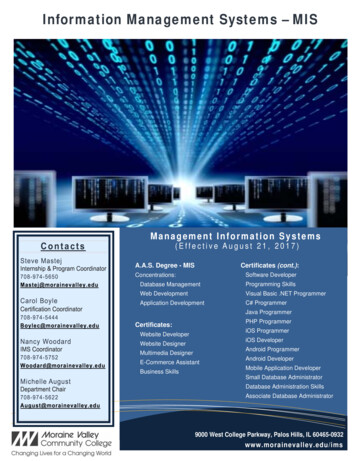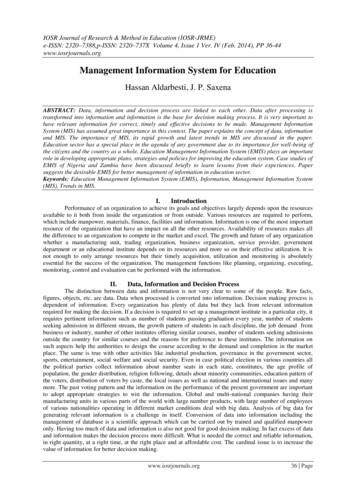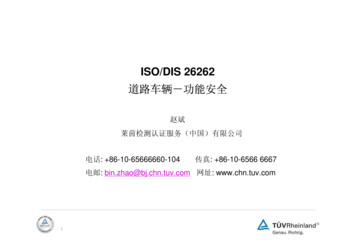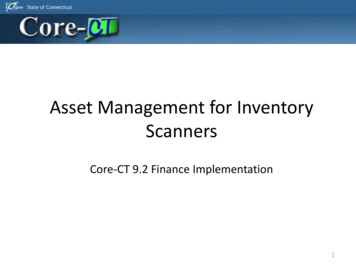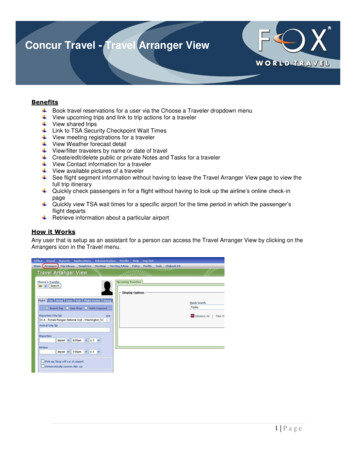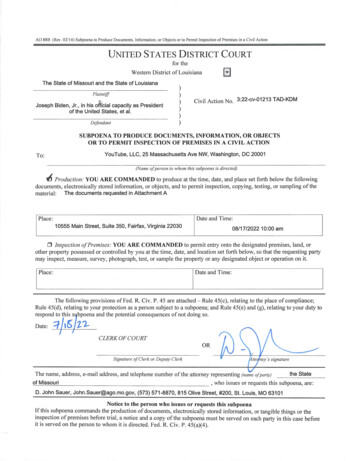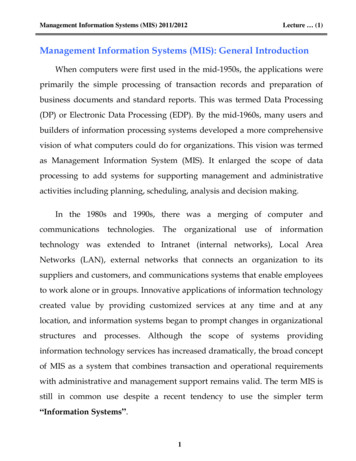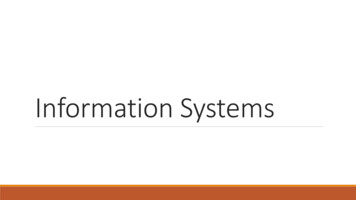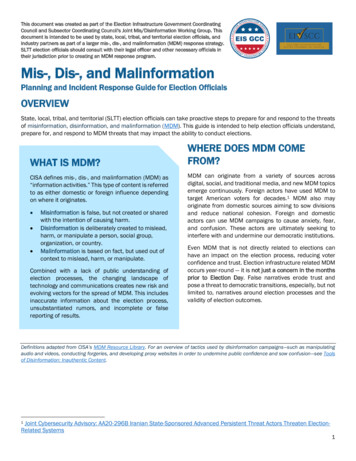
Transcription
This document was created as part of the Election Infrastructure Government CoordinatingCouncil and Subsector Coordinating Council's Joint Mis/Disinformation Working Group. Thisdocument is intended to be used by state, local, tribal, and territorial election officials, andindustry partners as part of a larger mis-, dis-, and malinformation (MDM) response strategy.SLTT election officials should consult with their legal officer and other necessary officials intheir jurisdiction prior to creating an MDM response program.Mis-, Dis-, and MalinformationPlanning and Incident Response Guide for Election OfficialsOVERVIEWState, local, tribal, and territorial (SLTT) election officials can take proactive steps to prepare for and respond to the threatsof misinformation, disinformation, and malinformation (MDM). This guide is intended to help election officials understand,prepare for, and respond to MDM threats that may impact the ability to conduct elections.WHAT IS MDM?CISA defines mis-, dis-, and malinformation (MDM) as“information activities.” This type of content is referredto as either domestic or foreign influence dependingon where it originates. Misinformation is false, but not created or sharedwith the intention of causing harm.Disinformation is deliberately created to mislead,harm, or manipulate a person, social group,organization, or country.Malinformation is based on fact, but used out ofcontext to mislead, harm, or manipulate.Combined with a lack of public understanding ofelection processes, the changing landscape oftechnology and communications creates new risk andevolving vectors for the spread of MDM. This includesinaccurate information about the election process,unsubstantiated rumors, and incomplete or falsereporting of results.WHERE DOES MDM COMEFROM?MDM can originate from a variety of sources acrossdigital, social, and traditional media, and new MDM topicsemerge continuously. Foreign actors have used MDM totarget American voters for decades.1 MDM also mayoriginate from domestic sources aiming to sow divisionsand reduce national cohesion. Foreign and domesticactors can use MDM campaigns to cause anxiety, fear,and confusion. These actors are ultimately seeking tointerfere with and undermine our democratic institutions.Even MDM that is not directly related to elections canhave an impact on the election process, reducing voterconfidence and trust. Election infrastructure related MDMoccurs year-round — it is not just a concern in the monthsprior to Election Day. False narratives erode trust andpose a threat to democratic transitions, especially, but notlimited to, narratives around election processes and thevalidity of election outcomes.Definitions adapted from CISA’s MDM Resource Library. For an overview of tactics used by disinformation campaigns—such as manipulatingaudio and videos, conducting forgeries, and developing proxy websites in order to undermine public confidence and sow confusion—see Toolsof Disinformation: Inauthentic Content.Joint Cybersecurity Advisory: AA20-296B Iranian State-Sponsored Advanced Persistent Threat Actors Threaten ElectionRelated Systems11
HOW DOES MDM IMPACT ELECTION SECURITY?Depending on the narrative, MDM can have various impacts on election security. Categories may include:ImpactDescriptionExample (from CISA’s Rumor Control page)ProceduralInterferenceNarratives or content related to electionprocedures that cause confusion andinterfere with officials’ ability tosmoothly administer an election.ParticipationInterferenceContent that might intimidate or detervoters from participating in the electionprocess.Delegitimization ofElection ResultsNarratives or content that delegitimizeselection results or sows distrust in theintegrity of the process based on falseor misleading claims.Personnel SecurityNarratives or content that falsely claimselection officials or poll workers are the“bad actor” attempting to interfere inelection results or processes.Reality: Safeguards are in place to prevent home-printedor photocopied mail-in ballots from being counted.Rumor: A malicious actor can easily defraud an electionby printing and sending in extra mail-in ballots.Reality: Voters are protected by state and federal lawfrom threats or intimidation at the polls, including fromelection observers.Rumor: Observers in the polling place are permitted tointimidate voters, campaign, and interfere with voting.Reality: Election results reporting may occur more slowlythan some voters expect. This alone does not indicate aproblem with the counting process or results, or that thereare issues affecting the integrity of the election. Officialresults are not certified until all validly cast ballots havebeen counted, including ballots that are legally counted afterelection night.Rumor: If results as reported on election night changeover the ensuing days or weeks, the process is hacked orcompromised, so I can’t trust the results.Reality: Robust safeguards including canvassing andauditing procedures help ensure the accuracy of officialelection results.Rumor: A bad actor could change election results withoutdetection.RESPONDING TO MDMIn today’s media and information environment, election officials must play a proactive role in responding to MDM. Whileeach MDM narrative will differ, leveraging the TRUST model for MDM response can help reduce risk and protect voters.TTell YourStoryRReady YourTeamUUnderstandand AssessMDMSStrategizeResponseTTrackOutcomesIt is important to acknowledge the opportunities and limitations of government-led MDM intervention—particularlywhere distrust of government may be fueling the narrative. Focus responses where your team has evidence,expertise, or authority to counter the MDM. Also, recruit trusted community partners to amplify your messaging.Categories adapted from the Election Integrity Project’s (EIP) final report on misinformation and the 2020 election (Revised March 2021).2
1. TELL YOUR STORYPublic resilience is increased as your team builds relationships with voters and stakeholders. Educate your communitiesabout election processes and MDM-related threats before they occur.Educate voters: Educating constituents on how to engage in the electoralprocess and promoting civic learning is critical to countering MDM.Communicating clearly in tone, language, and medium, as well asleveraging credible voices your audience trusts will help reach andengage constituents to convey information about importantdates/deadlines, polling locations, processes for voting change, andwhere to find trusted information about elections and election results.Media literacy includes verifying sources,seeking alternative viewpoints, and findingtrusted sources of information. The NationalAssociation for Media Literacy Education hasmembers in every state that can work withelection officials to develop media literacycontent. CISA’s Resilience Series graphicnovels are a great example of a resourceaimed at developing media literacy andcritical thinking to counter disinformation.Pre-bunk MDM: Providing constituents with information and resourcesbefore MDM activity emerges better equips Americans to identify andquestion false narratives. In some cases, by leveraging insights fromyour staff, you can anticipate where MDM narratives may arise, such ashow election officials secure elections through the use of post-election audits and similar safeguards. Addressing thesetopics with voters in advance of elections and explaining how they are used in MDM narratives can increase resiliency andconfidence among voters.Build media relationships: Reach out to local newspaper, radio, television, podcasts and other media outlets to buildworking relationships before election cycles. Invite them to learn more about how election processes secure election resultsand key voter education details. Make sure they have a contact in your office. Establishing working relationships with mediaoutlets and journalists helps quickly and pre-emptively debunk or expose MDM activity. It can also help inform accuratereporting around elections, limiting the propagation of misinformation.2. READY YOUR TEAMThe effectiveness of your response will depend on how much preparation is conducted internally ahead of MDM activity.Establish your response protocol: Establish a clear procedure for responding to MDM and educate team members aboutthe process. Understand the procedures for reporting or flagging potential online MDM to social media platforms often used byyour constituents. Consult with your legal counsel to ensure you respect constitutional rights and privacyprotections and abide by any legal restrictions.The Center for Internet Security (CIS) was established to support the cybersecurity needs of the electionsubsector. The CIS can be leveraged to report real-time MDM via email at misinformation@cisecurity.org. Be sureto include links and screenshots, as well as details on the misinformation and your jurisdiction.Determine internal roles and responsibilities, including an escalation process within your jurisdiction to ensurethe right teams are talking to one another while responding to MDM activity. Be clear that this is not “just” acommunications issue; it requires engagement from across departments to ensure responses are accurate andunderstandable.Designate an individual to be responsible for ensuring this process is established, updated, and shared bothinternally and with relevant stakeholders at the local, state, tribal, territorial, and federal levels — including yourCISA Regional Office.Hold or participate in tabletop exercises to increase your team’s awareness and understanding of MDM threats,evaluate your overall preparedness, identify deficiencies in your incident response plan, and clarify roles andresponsibilities during an incident. CISA can assist in development and execution of these exercises, or CISA’sTabletop in a Box resource can help you talk through possible scenarios with your team and stakeholders as well.Build credible information-sharing channels: MDM can thrive in the absence of easily accessible, credible information.Ensure your agency’s website, social media accounts, and other information channels are up to date and active so youcan directly respond to MDM. This can help your community have confidence that the messages your organizationsdisseminate are authoritative and you can further build public confidence in election administration.3
Register your website for a .gov address so the public does not have toguess whether your websites and emails are genuine. CISA makes .govdomains available solely to U.S.-based government organizations andpublicly controlled entities without a fee.Many social platforms (e.g., Facebook, Twitter) will also allow governmentorganizations and users to apply for verification badges. Local electionofficials should reach out to their state for more information on how to gettheir accounts verified.Consider pre-bunking MDM on your website by responding to commonquestions relevant to your responsibilities. The Rumor Control Start-UpGuide provides further guidance on establishing this webpage and how toassess which topics to include.Prepare for incoming questions: Ensure your office has methods for fielding publicfeedback and questions, including being able to handle a large influx of calls ormessages. Consider creating a shared voicemail and email inbox so that no oneperson becomes overwhelmed, with a log to track inquiries and responses. Thesemailboxes should be regularly checked and there should be an establishedprocess for determining who will respond. This will enable your team to bothuncover MDM that is circulating and keep systems and phone lines functioningduring critical periods of MDM activity. Ensure staff are aware of your office’sprocedures for reporting threats and harassment, and if possible, rotateresponsibilities for responding to calls and emails to avoid burnout.3. UNDERSTAND & ASSESSIt is important to understand, to your best ability, the full nature and scope of theMDM activity.Identify MDM activity: While every election jurisdiction has different resources andcapabilities, you should establish a system for identifying and evaluating MDM inyour office. Determine if it is appropriate for your office to engage with outsideorganizations or tools to better understand the risk landscape and monitor forMDM, including your technical systems provider. Monitoring may be proactive, viaanalytic tools, or reactive, through public feedback channels. Team Checklist Understand reportingmechanisms for flaggingMDM on social media. Determine roles andresponsibilities for MDMresponse. Designate an individualto oversee the MDMresponse process. Register your website fora .gov address. Apply for verificationbadges from socialmedia platforms. Develop a list ofcommon topics andquestions vulnerable toMDM. Ensure yourcommunication systemsare set up to handleincoming questions. Engage with counseland, if applicable, yourprivacy office to ensureprotection ofconstitutional rights andprivacy.Identify and continuously update a list of key elections-related processes and issues vulnerable to MDM, whetherthey are short-term trends or long-term narratives. Ensure all members of your office have access to this list andfeel comfortable contributing to it. The person responding to inquiries will therefore have a good sense of whattopics people are asking about, and who to contact for answers, even if they don’t know how to answer thequestion themselves.Identify the channels that constituents use to receive information. MDM content can spread through numerousmeans, including social media, mainstream media, word of mouth, online forums, messaging apps, and emails.Remember that MDM narratives also often move between channels, so content that appears on one platformmay also emerge elsewhere.For the high priority topics on your list, including those you worked to pre-bunk, you may want to take a moreproactive approach to monitoring for MDM narratives, to the extent permitted by law. Consider using analytic toolsto search for keywords related to MDM content. Evaluate content reach (how many people are seeing it),engagement (how many people are liking, sharing, or reacting to the content), how many channels it is presenton, and whether it has reached mainstream media. Consult with your legal counsel to determine what monitoringis permissible under law and platforms terms of service.Leverage publicly available analytical tools, such as those recommended by the RAND Corporation’s FightDisinformation at Home resource, which can help you gain a greater awareness of the information ecosystem.4
Assess the Risk: The team should identify what plausible risks are associated with MDM narratives and how they mayimpact election infrastructure. Mapping out existing MDM narratives and their impact on elections infrastructure will helpthe team be prepared for the online and offline consequences and impact to elections infrastructure.4. STRATEGIZE RESPONSEOnce you have identified MDM, it is important to craft an effectiveresponse, taking into account how the information environment andrelated technology may evolve.Determine your response: Based on your risk assessment, prioritizewhich MDM narratives to respond to. In crafting your communicationsstrategy, consider both timing and medium of response. Not all MDM activity warrants an immediate response.Deciding which rumors make the cut is an exercise of anorganization’s judgement — and that judgement may changeas MDM narratives evolve and community response changes.Understand your audience for the MDM intervention. Yourcommunity isn’t homogeneous, and your audience will changedepending on the message you are trying to convey and themedium you use. Adapt your messaging to the audiences youare trying to reach, such as new voters, veterans, individuals inspecific geographic regions, or those who speak otherlanguages.Apply communications best practices: In a crisis, specific tactics andlanguage can help build the credibility of your response and reassurevoters. Tactics may also look different based on the activity and theaudience. A communications strategy might include social media,radio, local news, or other media platforms to engage constituents. Election officials across the country arecombatting election-related MDM. The Colorado Secretary of State’s officeconducted social media and digitaloutreach to voters and set up a websiteto educate on the threat misinformationand respond to MDM narratives.The Kentucky Secretary of State’s officelaunched a Rumor Control page on theirwebsite to counter MDM narrativesaround elections.The Wisconsin Elections Commissionestablished a designated FAQ page toanswer voter questions about the 2020election.The Maricopa County, Arizona, ElectionsDepartment launched a website toaddress questions and misconceptionsabout the 2020 election and hasengaged in rumor control efforts acrosssocial media.Identify where your audience receives information and, if possible and advisable, establish a presence on theseplatforms. It will likely not be realistic for your office to actively use every platform. Focus on using a smallernumber of platforms effectively to establish your handle as a trusted source of information.Ensure you have the facts before responding.State facts first, rather than repeating a falsehood in your headline.Be careful not to amplify the source of the MDM by linking to it directly or sharing original images or videos. Ifreferencing an image, use a screenshot with a text overlay that explains the image is inauthentic or misleading.Consider what privacy protections are necessary for all media shared.Consider the length of your response. Shorter statements are more easily digestible and can be helpful when theMDM is easily disproven.You do not need to respond to each incident of MDM individually. Point back to your office’s previous posts,statements or work if MDM recirculates. Inconsistent messaging can create credibility problems.Leverage partnerships and trusted community messengers to counter MDM narratives. Repetition andconsistency are key. Conveying the same message through multiple mediums and platforms will help reach thebroadest audience possible.5
5. TRACK OUTCOMESAfter your response, evaluate the continued prevalence of MDM and evaluate ways to adjust processes moving forward.Manage and monitor repercussions: While MDM narratives may be effectively addressed or accounts spreadingdisinformation may be removed, manipulators will often find ways to circumvent these changes. Creating new accounts,adapting coded language, altering audio/visual material, and iterating on narratives already identified as objectionable byplatforms are all possible adjustments deployed to increase MDM efficacy. It is important to monitor the MDMenvironment, as resources allow, to remain aware of changes and adjust response tactics accordingly.Reassess response strategy: Following an MDM response effort, revisit and reassess your process, including your list ofpriority topics for media monitoring. In the current information environment, threats are constantly evolving, and thelocations, mediums, and narratives of MDM are changing as well.6
digital, social, and traditional media, and new MDM topics emerge continuously. Foreign actors have used MDM to target American voters for decades.1 MDM also may originate from domestic sources aiming to sow divisions reduce national cohesion. Foreign and domestic actors can use MDM campaigns to cause anxiety, fear, and confusion.
